Lyme disease, a bacterial infection primarily transmitted through the bite of infected ticks, has been a growing concern in recent years. Named after the town of Lyme, Connecticut, where it was first identified in the 1970s, this illness can have debilitating effects if left untreated. As cases continue to rise, understanding the symptoms, treatment options, and prevention methods becomes increasingly crucial. Let’s delve into the intricacies of Lyme disease to shed light on this often misunderstood condition.
Understanding Lyme Disease
Lyme disease is caused by the bacterium Borrelia burgdorferi and is primarily transmitted to humans through the bite of infected black-legged ticks, commonly known as deer ticks. These ticks are prevalent in wooded and grassy areas, making outdoor activities such as hiking, camping, and gardening potential risk factors for exposure.
Upon infection, the bacteria spread through the bloodstream, leading to a wide range of symptoms that can affect the skin, joints, heart, and nervous system. However, Lyme disease can be challenging to diagnose due to its varied presentation and the possibility of symptom overlap with other conditions.
Symptoms of Lyme Disease
The signs of Lyme disease may differ depending on the stage of the infection. In the early stages, which typically occur within days to weeks after a tick bite, individuals may experience:
Erythema migrans (EM) rash: Often resembling a bull’s-eye pattern, this distinctive rash appears at the site of the tick bite and gradually expands over time.
Flu-like symptoms: fever, chills, fatigue, headaches, muscle aches, and joint pain are common during the initial phase of the infection.
If left untreated, Lyme disease can progress to more severe symptoms, including:
Joint inflammation:
Lyme arthritis can cause swelling, stiffness, and pain, primarily affecting large joints such as the knees.
Neurological complications:
Some individuals may develop neurological symptoms such as numbness, tingling, Bell’s palsy (facial paralysis), and cognitive impairment.
Heart problems:

In rare cases, Lyme disease can lead to heart palpitations, chest pain, and inflammation of the heart muscle (myocarditis).
Diagnosis and Treatment
Diagnosing Lyme disease can be challenging due to the variability of symptoms and the potential for false-negative results in laboratory tests, especially during the early stages of infection. Healthcare providers often rely on a combination of clinical evaluation, medical history, and laboratory tests to make an accurate diagnosis.
Treatment for Lyme disease typically involves a course of antibiotics, such as doxycycline, amoxicillin, or cefuroxime axetil, depending on the patient’s age and the stage of the infection. Early detection and prompt treatment are essential to prevent the progression of the disease and minimize the risk of long-term complications.
In some cases, individuals with persistent symptoms, known as post-treatment Lyme disease syndrome (PTLDS), may require additional management to alleviate ongoing symptoms and improve their quality of life.
Prevention is Key
Preventing Lyme disease starts with minimizing exposure to ticks and taking precautions when spending time outdoors, especially in areas where ticks are prevalent. Here are some tips to reduce the risk of tick bites:
Use insect repellent:
Apply insect repellents containing DEET, picaridin, or permethrin to exposed skin and clothing.
Wear protective clothing:
wear long sleeves, pants, and socks to cover exposed skin, and tuck your pants into your socks to prevent ticks from crawling up your legs.
Perform tick checks:
After spending time outdoors, thoroughly check your body for ticks, paying close attention to areas such as the scalp, armpits, groin, and behind the knees.
Create a tick-safe environment:
Keep lawns mowed, remove leaf litter, and create a barrier of wood chips or gravel between wooded areas and recreational spaces to reduce tick habitat.
By incorporating these preventive measures into your outdoor routine, you can significantly reduce the risk of contracting Lyme disease and other tick-borne illnesses.
Conclusion
Lyme disease remains a significant public health concern, with increasing incidence rates in many parts of the world. Early recognition of symptoms, prompt treatment with antibiotics, and preventive measures to minimize tick exposure are essential components of effective Lyme disease management.
As researchers continue to explore new diagnostic techniques and treatment strategies, raising awareness about Lyme disease and its prevention remains paramount. By educating ourselves and others about the risks associated with tick bites and advocating for public health initiatives, we can work together to combat this persistent threat.
FAQs
Can Lyme disease be transmitted from person to person?
No, Lyme disease cannot be transmitted directly from person to person. It is primarily spread through the bite of infected ticks.
Are all ticks capable of transmitting Lyme disease?
No, not all ticks carry the bacteria that cause Lyme disease. Black-legged ticks (deer ticks) are the primary vectors of Lyme disease in North America.
How soon after a tick bite should I seek medical attention?
If you develop symptoms such as fever, rash, fatigue, or muscle aches after a tick bite, it’s essential to consult a healthcare provider promptly, especially if you live in or have recently visited an area where Lyme disease is prevalent.
Is Lyme disease contagious?
No, Lyme disease is not contagious and cannot be spread through casual contact with an infected individual.
Can pets transmit Lyme disease to humans?
While pets can become infected with Lyme disease, they cannot directly transmit the infection to humans. However, pets can carry infected ticks into the home, increasing the risk of human exposure.
Can Lyme disease be cured?
Lyme disease is treatable with antibiotics, especially when detected early. However, some individuals may experience persistent symptoms despite treatment, a condition known as post-treatment Lyme disease syndrome (PTLDS).
Are there vaccines available for Lyme disease?
At present, there isn’t a vaccine for Lyme disease available for purchase in the United States. However, research into Lyme disease vaccines is ongoing, with several candidates in development.

